A heartwarming story unravels as a lovable cat with unique needs, affected by the rare disease Mucolipidosis, finds her forever home with a veterinary student who played a significant role in rescuing her life! We first laid eyes on Mouse through a post shared by Melissa, who is the mother of Sasha and Lux, two special cats we previously featured, on Instagram. Initially, both Melissa and Heidi believed that Mouse had Mucopolysaccharidosis (MPS), similar to Sasha and Lux, which is a severe and uncommon condition. Since most people are unfamiliar with MPS, we have featured many cats with various types of mucopolysaccharidoses to spread awareness about this group of inherited metabolic diseases. We approached Heidi, who is studying veterinary science, to ask if she would like to feature Mouse, and although she agreed, she preferred to wait until the suspected diagnosis was confirmed. Finally, the results came out, and Mouse was diagnosed with Mucolipidosis Type II, also known as I-Cell Disease. We were eager for Heidi to share the specifics about this condition and how it affects Mouse. Moreover, we learned how Heidi adopted this adorable special needs cat in April 2022, which was very similar to how we adopted our first CH kitty, Mittens, who encouraged us to create Meow As Fluff after losing him right before his third birthday. We also discovered that while ML II has an impact on Mouse’s mobility, she is still pretty much an ordinary cat despite her condition, like most other special needs cats we’ve featured over the last six years. We are grateful to Heidi for taking time out from her studies to tell us Mouse’s story, and we hope you enjoy reading it as much as we did!

Heidi discovered Mouse, along with her two brothers and mother, in a yard located in Northern California in May 2021. At just four weeks old, the tiny feline was taken under the care of Hopalong Animal Rescue of Marin Humane. Since she was the smallest of the litter, she needed to be bottle-fed as she kept getting pushed off the nipple by her siblings.

Although her two brothers did not experience any developmental issues, Mouse’s foster observed that she was a classic case of failure-to-thrive at just seven weeks old. At the time, I was working as a vet assistant in a low-cost clinic that provided medical services, spays, and neuters for Hopalong when Mouse became one of our patients. She had a limp on her right front leg, looked odd, and was undersized for her age, but the vet could not diagnose her condition and gave her pain medication before sending her home.
However, when she returned a few weeks later to be spayed, we noticed that she was severely undernourished and bloated. Her mouth could only open to a centimeter, which meant that despite her voracious appetite, she could only manage to lick the gravy off her wet food. Given her physical condition, her veterinarians feared that she might have feline infectious peritonitis (FIP) or some other serious congenital abnormality, and euthanasia was considered.
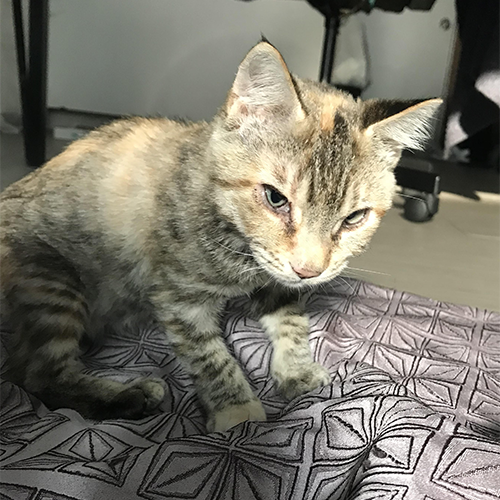
When I heard about Mouse’s condition, I knew I had to do something to help. So, I decided to become a hospice foster and take her into my home. My goal was to give her the best possible chance to recover from whatever was ailing her. Thankfully, she settled in quickly and showed signs of improvement almost immediately. Watching her play with toys and even use the bathroom for the first time in days was a huge relief. But what really won me over was the way she showered me with affection when I held her. Despite her rough exterior, Mouse was full of love and determination to keep on fighting.
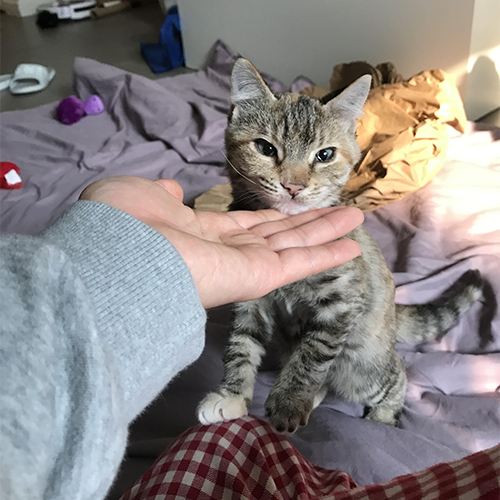
As a veterinary student, I was determined to diagnose my furry companion so that she can receive the best care possible. After being accepted to Cornell University, where I study, I decided to formally adopt her and bring her with me. It took almost two years, but finally, she was diagnosed with mucolipidosis type II (I-cell disease)! By the way, someone asked me about her name – it’s a story worth telling!
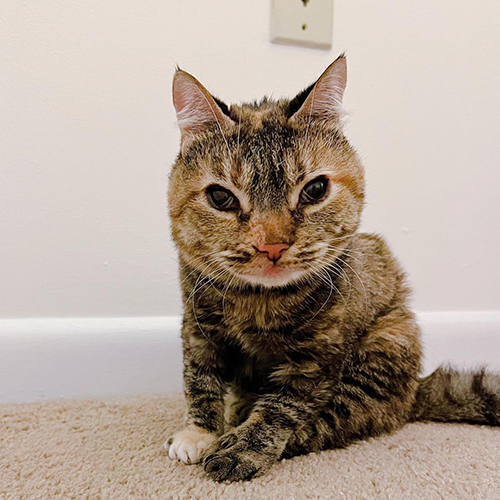
H:
The name Mighty Mouse was given to my foster cat by the organization that took care of her. I believe it was inspired by a cartoon character from the 1940s. However, I chose to keep the name because it suited her perfectly. Despite her tiny size of only 4.7 pounds, she is a strong and resilient fighter. Her name can be quite long, so I often call her Mouse or Mousey as a nickname.
MAF:
What led you to take in a cat with mucolipidosis type II?
H:
Mighty Mouse needed a home urgently as she was on the brink of being euthanized. I had no knowledge of her health condition when I adopted her. My primary motivation was to provide her with the love and care she deserves, regardless of her medical situation. I could not bear the thought of her being put down without anyone giving her a chance to live.
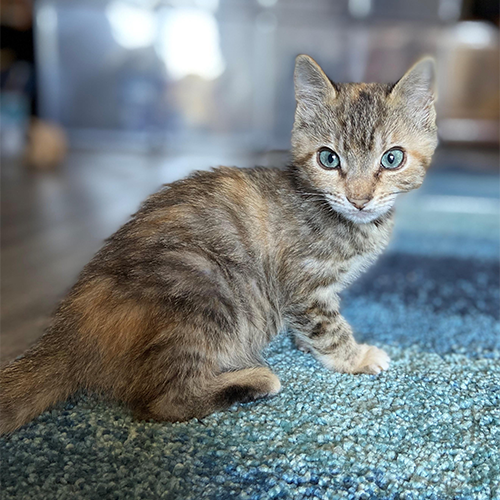
Knowing that my beloved pet Mouse has been diagnosed with mucolipidosis type II (I-cell disease), I am confident that I am the best qualified owner to take care of her. This rare disease is so uncommon that even most veterinarians have never heard of it. To ensure Mouse’s well-being, I am using my connections and resources at Cornell University to get her examined by all the specialty departments. Additionally, I am in communication with Dr. Casal, an expert researcher on lysosomal storage diseases at the University of Pennsylvania. We are currently in the process of getting Mouse’s genome sequenced and aim to publish her case in the future. Mucolipidosis type II (I-cell disease) is a metabolic disorder caused by a mutation that hinders the production of an enzyme necessary for the digestion of GAG proteins. These proteins occur in various places throughout the body, such as joints and eyes. Therefore, it explains why Mouse has osteoarthritis and is mostly blind at such a young age.
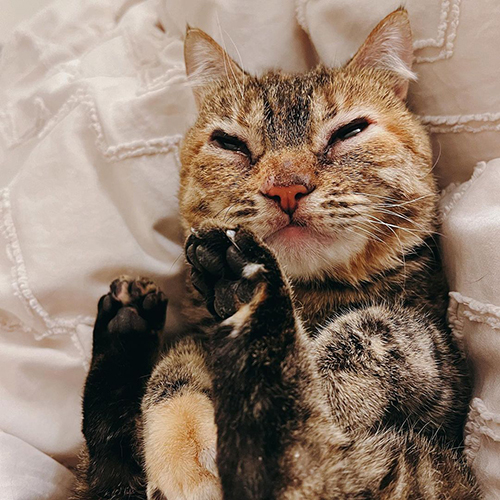
From the tender age of four months, she has experienced varying levels of stiffness throughout her body. As she reached 6-8 months old, she lost the ability to spring towards her toys and began walking with a stilted gait. Due to her mobility struggles, she struggles with constipation, leading to me feeding her a special gastrointestinal health-oriented diet. Additionally, as Mouse is unable to groom herself, I frequently give her baths.
Arthritis remains Mouse’s primary problem. Consequently, she receives daily maintenance pain medication and utilizes the Assisi Loop Lounge, which harnesses targeted electromagnetic pulses to minimize inflammation in her joints. This technique offers an excellent non-invasive pain management solution for geriatric patients.
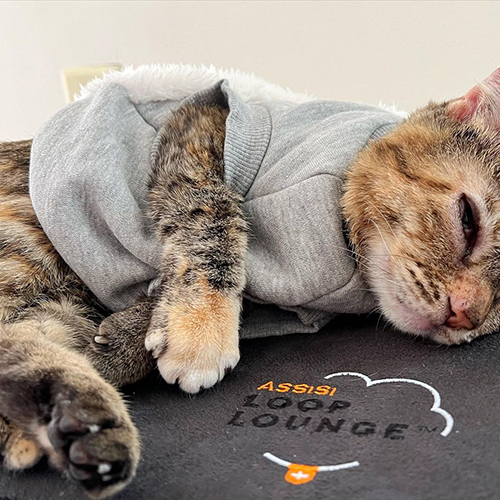
Typically, cats suffering from arthritis are prescribed joint supplements containing glucosamine or other GAG proteins. However, my cat Mouse cannot digest these due to her condition. Therefore, I have decided to try giving her Flexadin UC-II instead. This type of supplement works by fooling the immune cells in her body into stopping the attack on collagen present in her joints. Our goal is to slow down the degenerative joint disease process that she is experiencing. Additionally, I provide her with daily massages and physical therapy exercises to aid in her recovery.
MAF:
In your opinion, what are some misunderstandings that people may have about cats with special needs and those who have ML II?
H:
Judgments from other people regarding pet care can be overwhelming for owners of special needs pets, especially those with lysosomal storage disease. Many people comment on social media posts and claim that we are being inhumane by not euthanizing our pets. However, these people often lack a complete understanding of the situation and base their opinions on limited information. As owners, we only share snippets of our pets’ lives, making it easy for others to form snap judgments without seeing the whole picture. Unfortunately, as we expose our pets’ vulnerabilities to the public, we cannot avoid receiving hate comments.
It would be great if more people could understand the purpose of sharing our experiences – to create awareness and connect with others – instead of giving their opinions on whether we should keep our pets alive or not. It’s common for ML II and MPS cats to have facial dysmorphia, which can make them look unusual but doesn’t necessarily mean they’re in poor health. They still do normal cat things, like my own cat Mouse who I caught with half her body inside a bag of cat food I forgot to close properly.
MAF:
Can you share some of the difficulties that have come with taking care of Mouse who has ML II?
H:
One of the biggest challenges I face with Mouse’s condition is the uncertainty of how long she will live. Unfortunately, ML-II is a rare disease and research on it is limited. According to current literature, feline patients with this condition only live up to 7-8 months of age. However, Mouse is turning two years old in April, so I believe we’re doing well. Despite this, every time she shows any unusual symptom or behavior, I get worried about her health. I know many pet owners with special needs animals can relate to this feeling.

To be honest, taking care of Mouse’s medical needs doesn’t pose any difficulties or challenges for me. I am more than happy to assist her in any way I can, acting as her eyes and legs for as long as she wants to stay with me. Plus, I consider myself fortunate to be studying at Cornell University, where I’m surrounded by exceptional veterinarians. She has already received treatment from the Neurology, Sports Medicine, and Ophthalmology departments, and we have plans to visit the Cardiology department soon. It’s heartening to see how supportive and invested everyone is in her well-being, and it gives me immense pleasure that Mouse has a strong community backing her up.
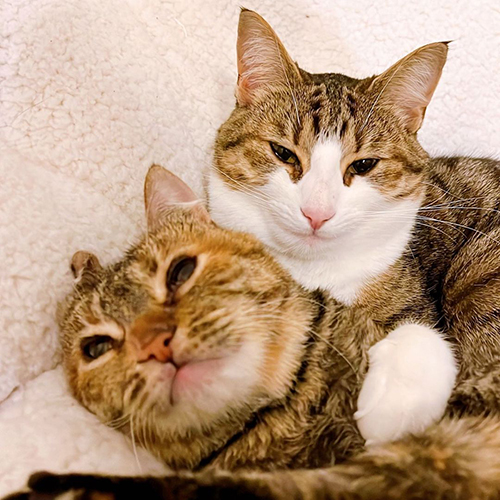
It’s unsettling to think that we cannot predict the duration of our life, but it reminds me to cherish every moment I spend with my feline companion, Mouse. She is irreplaceable and means the world to me.
In regards to special needs cats, specifically those with ML II, I wish more people were educated on the topic of anticipatory grief. It’s a struggle for pet owners whose furry friends suffer from chronic illnesses to overcome the anxiety that comes with the inevitable deterioration of their health. I have personally experienced numerous breakdowns just thinking about a time when Mouse will lose her ability to walk or become so ill that I must bid farewell. In contrast, Mouse remains content and happy as she purrs beside me.